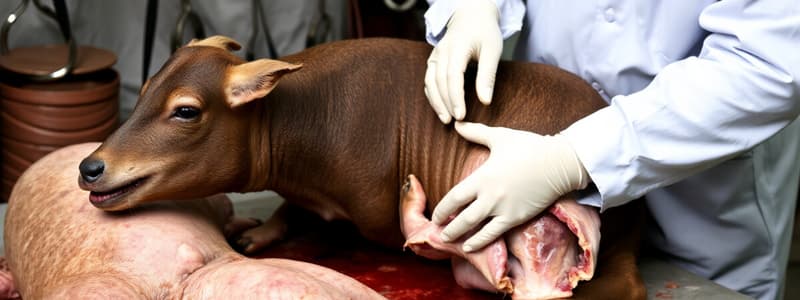Podcast
Questions and Answers
What are the primary objectives of antemortem inspection in animals destined for slaughter?
What are the primary objectives of antemortem inspection in animals destined for slaughter?
The primary objectives include screening animals, ensuring humane treatment, reducing contamination, and identifying diseases.
Why is it important to conduct antemortem inspections in proper lighting?
Why is it important to conduct antemortem inspections in proper lighting?
Proper lighting is essential for accurately observing animals' behavior, health status, and any abnormalities.
What types of abnormalities should inspectors look for during antemortem inspections?
What types of abnormalities should inspectors look for during antemortem inspections?
Inspectors should look for abnormalities in respiration, behavior, gait, posture, structure, color, odor, and any abnormal discharges.
How do antemortem inspections help in the prevention of contamination on the killing floor?
How do antemortem inspections help in the prevention of contamination on the killing floor?
What should be done with animals that show signs of pain or suffering during antemortem inspection?
What should be done with animals that show signs of pain or suffering during antemortem inspection?
What abnormal behavior might indicate a nervous disease in an animal?
What abnormal behavior might indicate a nervous disease in an animal?
List two physical signs of structural abnormalities in animals.
List two physical signs of structural abnormalities in animals.
What are some examples of abnormal discharges from an animal's body?
What are some examples of abnormal discharges from an animal's body?
Why is postmortem inspection important in evaluating carcasses?
Why is postmortem inspection important in evaluating carcasses?
What techniques are used during postmortem inspections to evaluate lesions?
What techniques are used during postmortem inspections to evaluate lesions?
When trimming or condemning a carcass, what criteria are used?
When trimming or condemning a carcass, what criteria are used?
What might a dull and anxious expression in an animal indicate?
What might a dull and anxious expression in an animal indicate?
What is meant by 'localized' and 'generalized' conditions in postmortem findings?
What is meant by 'localized' and 'generalized' conditions in postmortem findings?
Flashcards
Antemortem Inspection
Antemortem Inspection
A process to screen animals for slaughter, ensuring proper rest, clinical information, and humane treatment.
Objectives of Antemortem Inspection
Objectives of Antemortem Inspection
To screen animals, ensure proper rest and clinical data, reduce contamination, identify reportable diseases, and identify sick or treated animals.
Animal Abnormalities
Animal Abnormalities
Unusual signs in respiration, behavior, gait, posture, structure, discharges/protrusions, color, and odor, which indicate potential illness or injury.
Respiratory Abnormalities
Respiratory Abnormalities
Signup and view all the flashcards
Separating Suspect Animals
Separating Suspect Animals
Signup and view all the flashcards
Abnormal Animal Behavior Signs
Abnormal Animal Behavior Signs
Signup and view all the flashcards
Abnormal Gait Causes
Abnormal Gait Causes
Signup and view all the flashcards
Structural Abnormalities
Structural Abnormalities
Signup and view all the flashcards
Abnormal Body Discharges/Protrusions
Abnormal Body Discharges/Protrusions
Signup and view all the flashcards
Postmortem Inspection Purpose
Postmortem Inspection Purpose
Signup and view all the flashcards
Carcass Condemnation Criteria
Carcass Condemnation Criteria
Signup and view all the flashcards
Postmortem Inspection Techniques
Postmortem Inspection Techniques
Signup and view all the flashcards
Carcass Trimming/Condemnation
Carcass Trimming/Condemnation
Signup and view all the flashcards
Study Notes
Antemortem Inspection
- Aims to screen all animals destined for slaughter
- Ensures animals are properly rested and allows for clinical information gathering for disease diagnosis
- Reduces contamination on the killing floor by separating dirty and diseased animals
- Ensures injured animals receive emergency slaughter and humane treatment
- Identifies reportable animal diseases to prevent contamination
- Identifies animals treated with antibiotics, chemotherapeutics, insecticides, and pesticides
- Requires proper cleaning and disinfection of livestock transport trucks
- Inspections should be performed with proper lighting to observe animal behavior, nutritional status, cleanliness, and signs of disease/abnormalities
- Abnormalities in respiration - different breathing patterns
- Abnormalities in behavior - includes walking in circles, abnormal gait/posture, head-butting, charging at objects, aggressiveness, dullness/anxiety in eyes
- Abnormal gait – associated with pain in legs, chest, or abdomen, or nervous disease
- Abnormalities in structure/conformation - includes swellings (abscesses), enlarged joints, umbilical swelling, enlarged jaw ("lumpy jaw"), bloated abdomen, abnormal discharges/protrusions (nose, mouth, vulva, rectum/uterus, vagina, growths on eyes, bloody diarrhoea)
Postmortem Inspection
- Crucial for detecting carcass abnormalities and ensuring only fit products are passed as food
- Keeps organs and carcass portions together
- Utilizes professional/technical knowledge to evaluate pathological lesions
- Viewing, incision, palpation, and olfaction techniques are employed
- Classifies lesions as acute or chronic
- Establishes condition localization/generalization and extent of systemic changes in other organs/tissues
- Determines significance of primary/systemic lesions and their relevance to major organs (liver, kidneys, heart, spleen, lymph system)
- Coordinates antemortem and postmortem findings to make a final diagnosis
- Submits samples to a lab for diagnostic support if applicable
Carcass Judgement/Trimming/Condemnation
- Involves removing any portion of a carcass that is abnormal or diseased
- Removes any carcass part that may pose a hazard to human health
- Removes any part of the carcass that is repulsive to the consumer
Specific Inspection (Cysticercus Bovis)
- Part of inspection for cattle/calves over 6 weeks
- The muscles of mastication should be viewed and incised.
- Linear incisions are aligned parallel to the lower jaw, reaching the internal and external muscles of mastication.
Studying That Suits You
Use AI to generate personalized quizzes and flashcards to suit your learning preferences.

![Ante-Mortem Analysis for Rabies Diagnosis [Trans 2023]](https://images.unsplash.com/photo-1542868727-5b8fcd21495e?crop=entropy&cs=srgb&fm=jpg&ixid=M3w0MjA4MDF8MHwxfHNlYXJjaHwzMHx8dmlyYWwlMjBhbnRpZ2VucyUyMHN0b29sJTIwc2FtcGxlcyUyMEVMSVNBJTIwY2xpbmljYWwlMjBkaWFnbm9zaXN8ZW58MXwwfHx8MTcwMzM1MjI0N3ww&ixlib=rb-4.0.3&q=85&w=300&fit=crop&h=200&q=75&fm=webp)
